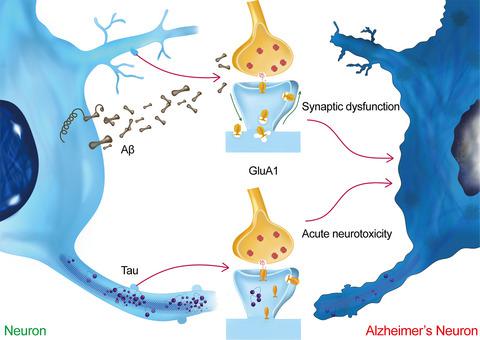当前位置:
X-MOL 学术
›
Cell Prolif.
›
论文详情
Our official English website, www.x-mol.net, welcomes your
feedback! (Note: you will need to create a separate account there.)
Emerging role of AMPA receptor subunit GluA1 in synaptic plasticity: Implications for Alzheimer's disease
Cell Proliferation ( IF 5.9 ) Pub Date : 2020-11-13 , DOI: 10.1111/cpr.12959 Wenrui Qu 1, 2 , Baoming Yuan 3 , Jun Liu 1 , Qianqian Liu 1 , Xi Zhang 4 , Ranji Cui 2 , Wei Yang 2 , Bingjin Li 2
Cell Proliferation ( IF 5.9 ) Pub Date : 2020-11-13 , DOI: 10.1111/cpr.12959 Wenrui Qu 1, 2 , Baoming Yuan 3 , Jun Liu 1 , Qianqian Liu 1 , Xi Zhang 4 , Ranji Cui 2 , Wei Yang 2 , Bingjin Li 2
Affiliation

|
It is well established that GluA1 mediated synaptic plasticity plays a central role in the early development of AD. The complex cellular and molecular mechanisms that enable GluA1‐related synaptic regulation remain to fully understood. Particularly, understanding the mechanisms that disrupt GluA1 related synaptic plasticity is central to the development of disease‐modifying therapies which are sorely needed as the incidence of AD rises. We surmise that the published evidence establishes deficits in synaptic plasticity as a central factor of AD aetiology. We additionally highlight potential therapeutic strategies for the treatment of AD, and we delve into the roles of GluA1 in learning and memory. Particularly, we review the current understanding of the molecular interactions that confer the actions of this ubiquitous excitatory receptor subunit including post‐translational modification and accessory protein recruitment of the GluA1 subunit. These are proposed to regulate receptor trafficking, recycling, channel conductance and synaptic transmission and plasticity.
中文翻译:

AMPA 受体亚基 GluA1 在突触可塑性中的新作用:对阿尔茨海默病的影响
众所周知,GluA1 介导的突触可塑性在 AD 的早期发展中起着核心作用。实现 GluA1 相关突触调节的复杂细胞和分子机制仍有待完全了解。特别是,了解破坏 GluA1 相关突触可塑性的机制对于开发疾病修饰疗法至关重要,随着 AD 发病率的上升,这种疗法非常需要。我们推测,已发表的证据将突触可塑性缺陷确立为 AD 病因学的核心因素。我们还强调了治疗 AD 的潜在治疗策略,并深入研究了 GluA1 在学习和记忆中的作用。特别,我们回顾了目前对赋予这种无处不在的兴奋性受体亚基作用的分子相互作用的理解,包括 GluA1 亚基的翻译后修饰和辅助蛋白募集。这些被提议用于调节受体运输、回收、通道传导和突触传递和可塑性。
更新日期:2020-11-13
中文翻译:

AMPA 受体亚基 GluA1 在突触可塑性中的新作用:对阿尔茨海默病的影响
众所周知,GluA1 介导的突触可塑性在 AD 的早期发展中起着核心作用。实现 GluA1 相关突触调节的复杂细胞和分子机制仍有待完全了解。特别是,了解破坏 GluA1 相关突触可塑性的机制对于开发疾病修饰疗法至关重要,随着 AD 发病率的上升,这种疗法非常需要。我们推测,已发表的证据将突触可塑性缺陷确立为 AD 病因学的核心因素。我们还强调了治疗 AD 的潜在治疗策略,并深入研究了 GluA1 在学习和记忆中的作用。特别,我们回顾了目前对赋予这种无处不在的兴奋性受体亚基作用的分子相互作用的理解,包括 GluA1 亚基的翻译后修饰和辅助蛋白募集。这些被提议用于调节受体运输、回收、通道传导和突触传递和可塑性。











































 京公网安备 11010802027423号
京公网安备 11010802027423号